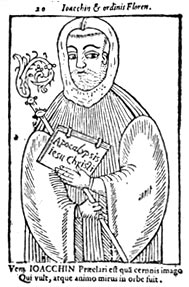Bible Knowledge Graph
Joachim of Fiore
- Entity ID:
- joachim-of-fiore
- Long Name:
- Joachim of Fiore (c. 1132-1202)
- Short Name:
- Joachim of Fiore
- Disambiguation String:
- Mystic
- Entity Type:
- person
- Entity Subtype:
- author
-

- Wikipedia
- Summary:
-
Born in the small village of Celico near Cosenza, in Calabria (at the time part of the Kingdom of Sicily), Joachim was the son of Mauro, a well-placed notary, and of Gemma, his wife. He was educated at Cosenza, where he became first a clerk in the courts, and then a notary himself, and worked in 1166-1167 for Stephen du Perche, archbishop of Palermo from 1167 to 1168 and counsellor of Margaret of Navarre, regent for the young William II of Sicily.
About 1159 he went on pilgrimage to the Holy Land, an episode about which very little is known, save that he underwent a spiritual crisis and conversion in Jerusalem that turned him away from a worldly life. When he returned, he lived as a hermit for several years, wandering and preaching before joining the ascetic Cistercian abbey of Sambucina near Luzzi in Calabria, as a lay brother, where he devoted his time to lay preaching. Under pressure from the ecclesiastical authorities, he joined the monks of the Abbey of Corazzo, and was ordained priest, apparently in 1168. He applied himself entirely to Biblical study, with a special view to uncovering the arcane meaning concealed in the Scriptures, above all in Revelation. To his dismay, the monks of Corazzo proclaimed him their abbot (c. 1177). He then attempted to join the monastery to the Cistercian Order, but was refused because of the community's poverty. In the winter of 1178 he appealed in person to William II, who granted the monks some lands.
In 1182 Joachim appealed to Pope Lucius III, who relieved him of the temporal care of his abbey, and warmly approved of his work, bidding him continue it in whatever monastery he thought best. Joachim spent the following year and a half at the Cistercian Abbey of Casamari, where he engaged in writing his three great books, his dictations keeping three scribes busy night and day; there the young monk, Lucas (afterwards Archbishop of Cosenza), who acted as his secretary, was amazed to see so famous and eloquent a man wearing such rags, and the wonderful devotion with which he preached and said Mass.
In 1184 he was in Rome, interpreting an obscure prophecy found among the papers of Cardinal Matthew of Angers, and was encouraged by Pope Lucius III. Succeeding popes confirmed the papal approbation, though his manuscripts had not begun to circulate. Joachim retired first to the hermitage of Pietralata, writing all the while, and then founded the Abbey of Fiore (Flora) in the mountains of Calabria. He refused the request of King Tancred of Sicily (reigned 1189-1194) to move his new religious foundation to the existing Cistercian monastery of Santa Maria della Matina. Flora became the center of a new and stricter branch of the Cistercian order, approved by Celestine III in 1198.
In 1200 Joachim publicly submitted all his writings to the examination of Innocent III, but died before any judgment was passed. The holiness of his life was widely known: Dante affirmed that miracles were said to have been wrought at his tomb, and, though never officially beatified, he is still venerated as a beatus on May 29.
He theorized the dawn of a new age, based on his interpretation of verses in the Book of Revelation, in which the Church would be unnecessary (which, of course, was considered heresy) and in which infidels would unite with Christians. Members of the spiritual wing of the Franciscan order acclaimed him as a prophet.
His popularity was enormous in the period, and some sources hold that Richard the Lionheart wished to meet him to discuss the Book of Revelation before leaving for the Third Crusade of 1189-1192.
His famous Trinitarian "IEUE" interlaced-circles diagram was influenced by the different 3-circles Tetragrammaton-Trinity diagram of Petrus Alphonsi, and in turn led to the use of the Borromean rings as a symbol of the Christian Trinity (and possibly also influenced the development of the Shield of the Trinity diagram).
- Viaf ID:
- 78749939
- DB Pedia ID:
- Joachim_of_Fiore
- Biblical Status:
- canonical
- Is An Individual:
- Yes
- Is Published:
- Yes
- Birth Date:
- AD 1132
- Death Date:
- March 30, 1202
- Occupation:
- Mystic
- Works:
